WE have received from our various correspondents quite a number of requests for us to publish something about the minor household conveniences. In compliance therewith we present the following details with explanatory illustrations, for which we are indebted to the American Agriculturist, for the particular benefit of those residing remote from cities, who are desirous of learning how such commodities are arranged.
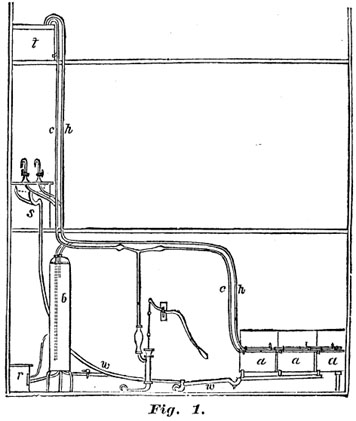
Fig. 1 gives a general view of a 2 1/2 story house with the main apparatus in the first story. Though this is usually placed in the basement, we can easily imagine the pipes carried up into time story above. The tank t is filled from the roof, or by the pump.
The cold water pipe c carries the cold water down to near the bottom of the water-tight copper boiler b, and forces the hot water out through the pipe h, entering a little way into the top, by which it is carried up to the sink s in the next story, to the stop-cocks in the wash-trays a a a, or anywhere else in the house, provided the point be not higher than the tank. By means of the force-pump the cold water is driven into the trays, if time stop-cocks be open; if the latter be closed it is forced into the boiler, or up into the tank when desired. The cold water pipe is always kept full and ready to supply bath-tubs, wash-stands, etc., by the pressure from the tank. Filthy water is carried away by time waste pipe w.
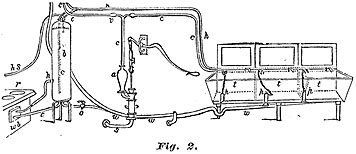
Fig. 2 represents a simpler form of the same apparatus. The boiler b is of strong copper, riveted, and of a strength proportional to the pressure. For a tank in the 2d or 3d, the Croton Pressure strength is used. Starting from the bottom of the tank, a pipe runs through the chimney back (not shown in the cut) to a water-back w b in the range r, from which another pipe, h, runs back into the boiler at a higher point.
This water-back is composed of a strong iron box, of about 10 or 14 inches long, 6 to 10 inches high, and about 2 inches thick; and it takes the place of the rear fire-brick in time fire-chamber of time range or cook-stove, so that it is always in direct contact with the fire, but being always full of water it does not burn out. In this the water is warmed; rises through h,while cold water flows in through c. A boiler holding from 35 to 45 gallons is sufficient for a medium house; 30 gallons will do for a small house. A waste-pipe should leave at time lowest point with a stop-cock o, so as to draw off any sediment which may collect in the boiler. From the hot water pipe, branches run to any points desired: as, h s, to a sink in the kitchen, another to the wash-trays t t t. The water is drawn, by means of the pump, through the supply pipe s, from the cistern or well, and forced up into the tank, or out any point where the stop-cock may be opened. A valve v in the horizontal pipe above the pump prevents drawing water from the tank into the trays, two pipes thus answering to carry hot or cold water up or down. The water pipes w w w carry out all water through the wall into the drain. The bend in this, near time first tray, is called the stench trap, the bend always keeping full of water, so that no odors can pass back from the drain. A broad screw should always be placed at the bottom of the bend to remove any obstruction which may settle there. The wash-trays are made of strong, clear pine plank, l ? to l ? inches in thickness, let into each other at the joints, and these well smeared with white-lead ground in oil, before putting the pieces together. The case is divided into two or three compartments. The back and end pieces are perpendicular, and the front pieces inclined in at the bottom, so that, while time tub is 19 or 20 inches wide at the top, inside measurement, it is only 13 to 14 inches wide at the bottom; perpendicular depth inside, 14 inches. The top front edge should stand about 33 inches above the floor, and the length of the trays should be about 2 feet each. The bottom board is a little inclined to the left, and in the lowest rear corner of each tray is a waste-pipe p, with metallic plug attached to a chain from near the top, so that it can be opened readily. Two trays are convenient for different kinds of suds or clothes, and a third still more so for rinsing. The covers when neatly fitted form a convenient ironing table when shut down. Turning a stop-cock lets the water into the trays; cold water is pumped directly in, or may be drawn from the tank if the supply be great enough; by omitting the valve v and by lifting the plug the wash water runs away.
This whole apparatus may be in the kitchen. All pipes should be kept from the walls at least by a board, and should be run up by the side of a chimney, or through a closet and not against the outer wall. Lead pipes when passing through wood-work should fit closely, or be surrounded within cement and broken glass, other-wise rats, in attempting to enlarge a passage, will sometimes cut through the lead pipe.
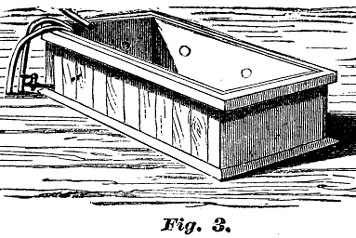
Fig. 3 shows the tank in some upper room, with its top a little below the eaves-trough, from which an in-let-pipe is shown. The dark spot just below it indicates the overflow-pipe, running down to the cistern. The hot and cold water pipes are shown coming up from below. The tank is made with l ? inch matched plank, built inside a scantling or wall-strip frame, and is lined with sheet-lead well soldered. Two of the plumbers tacks are indicated on one side, that is, the lead is let into the wood at these points; the indenture being covered with solder to prevent any weakness from the beating in of the lead. These ?tacks? prevent the lead from sagging down at the sides, as it will usually do, after long exposure to alternate heat and cold. In building, stronger studding and closer joists should be carried up under the tank to support the great weight of water. Each cubic foot of contents holds nearly 7 gallons, or about 4 feet to the barrel; 4 by 6, 3 feet deep, will hold about 650 gallons, or 21 barrels. The tank should always be closely covered, and have a trap door in the cover to look into the tank. The latter is cleaned of any sediment once a year or so. Pipes with branches extend from this to the boiler, to the bath-room, wash-sinks, etc. A stop-cock in the pipe where it leaves the bottom of the tank is desirable, both to cut off the water from descending if leakage occurs below, and also when cleaning out or washing the tank itself. A metallic strainer is put over the head of the discharge pipe, to stop any leaves or other material entering the tank to clog it.
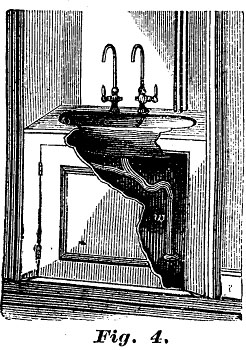
Fig. 4 shows the ‘Butler’s sink’ with the front door and casing below partly removed, to show the waste pipe w, from which a branch extends to the strainer, placed at the upper edge of the oval sink to prevent its overflowing, if the stop-cocks should by chance be left open. A chain plug in the bottom opens directly into the waste pipe w.
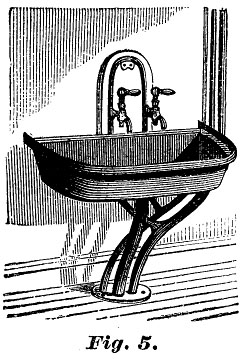
Fig. 5 shows sink, etc., with hot and cold water and waste-pipes. The two supply-pipes are seen in the corner. This, of course, is all cased in neatly, with door in front. The stop-cocks are set high enough above the sink to admit a pail under them.
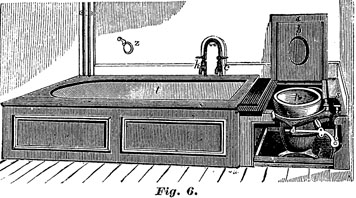
Fig. 6 shows the bath-tub and water-closet, with the casing removed from the latter in front, in order that the internal arrangement may be seen; p is the earthen-ware basin, having a metal basin under it, which is turned down by raising the handle, and this movement also lets cold water into the rim of the porcelain nearly horizontally, so as to wash it. The large 4-inch waste-pipe below has a stench trap. The walnut cover a and seat b are both on hinges, so that by opening both the wide porcelain bowl answers for receiving slops. The hot and cold water pipes are seen in the corner and the supply stop-cocks at h and c; the bell-pull at z; the bathing-tub at t, neatly cased in with panels. The French pattern bathing-tub is now generally preferred, about 21 inches depth, 23 inches wide, and 4 to 4 ? feet long at the top. Bell-hanging, ventilators, dumb-waiters, cornices, brackets, etc., we will describe in our following number.
